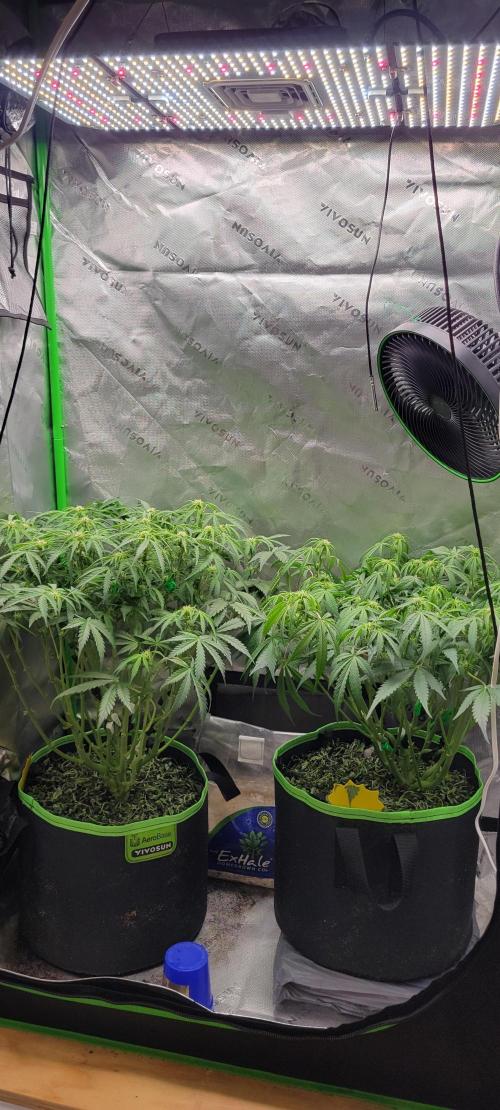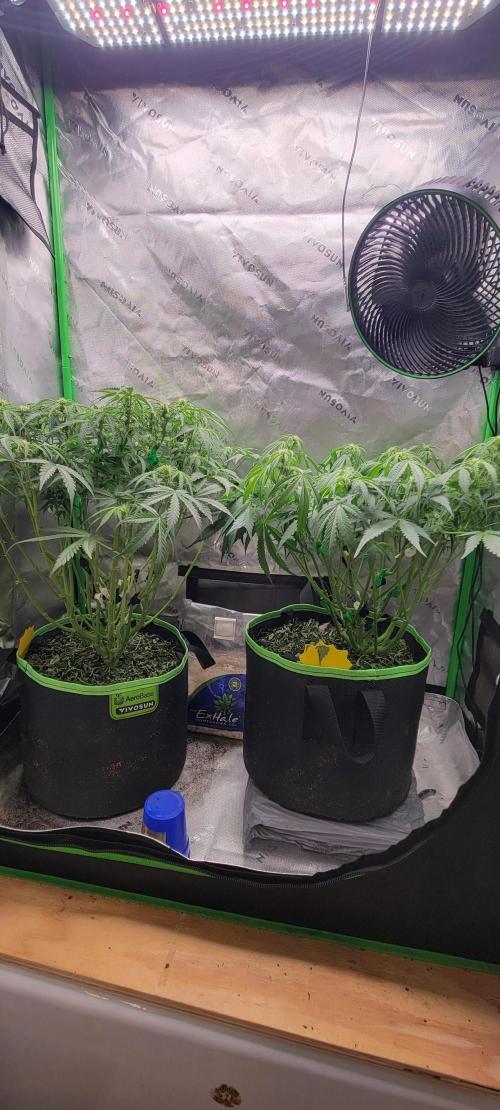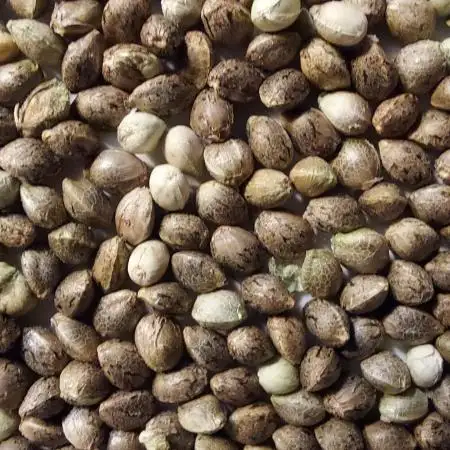The Grow Awards 2026 🏆
Small tent issues
PavementPunkstarted grow question 5mo ago
Im running out of verical space to move my light up higher as my plants stretch. Can i turn the power to the light down some from 80%? Its worth noting I have a 200 watt aerolight in my 20" by 36" tent that was meant for a 2x4 tent so ive been keeping it 20 inches from the canopy
Solved
likes
00110001001001111Oanswered grow question 5mo ago
Context:
4.17 sq ft.
18 hour operation for autoflowers
2.75 umol/J x 200watts = max of 550 umol/s PAR (or PPF not ppfd)
spec sheet: https://vivosun.com/vivosun-smart-grow-system-aerolight-a200se-compatible-with-growhub-e25-controller-p142504424325359396-v142527788947495192
So, i'd stick to 14-18" based on their own par maps provided. I was looking at a AW200SE because i can't find an A200SE. So, need to make sure that's the same thing. i've put in too much effort already looking, lol. Maybe, start at 40% and amp up from there -- if you provide appropriate amounts of CO2, can likely go higher. you'll save 4-6" of height and still get excellent coverage end to end of canopy.
CO2 bags are pretty inconsistent. Without any atmospheric co2 reading, i would not assume you are reaching 1200-1300ppm with a grow bag for the entire 18 hours of light operation, which is what the "125%" figure below is based on - if you read that far, lol.
This suggestion depends heavily on the accuracy of spec sheet from vivosun, which is not a wise thing to have a lot of confidnece in.
If efficacy is actually 2.5umol/J:
45% power
IF efficacy is actually 2.0umol/J:
55% power
You can see how this significantly impacts the percentage of power needed to give ~35-40 DLI. For co2 supplementation your target is higher. It is proportions. so 50/40 = 125% more power for ~50 DLI. 55% * 1.25 = 68.75% power for the 2.0umol/J efficacy example. You can apply this math to any of the suggestions.. .125% more will be approaching 50DLI. (it's a bit less because i think the value is 37DLI not 40 DLI - rounding is okay as this is just a ballpark concept)
Again, these are starting points only... you still need to observe and adjust to fine-tune it, but should not require much adjustment. Local variables will make for a shifting "max" DLI. it's 'relative' to each loosely controlled garden. You may find seasonal differences, if you don't tightly control the environment, too.
Regarldess the light is very over-powered for your context. You can also reduce hours of light to proportionally reduce DLI. e.g. you can go to 12 hours, and that's 2/3rds of the previous DLI over 18h, all other factors remaining the same. Becareful of dobuling up changing power and hours.. just takes a little math to figure out the effect if you move 2 dials at once. this may be a valid option as drivers tend to be more efficient at higher loads, unlike diodes. I'd rather run it at a higher power for fewer hours in this case, but only if doing so from the start. The plant has adapted to what you've done so far, so i'd stick to a similar hours of operation this time, but in future, consider more power, fewer hours so you don't run it at 50% or less. This depends on the driver. Youcan always look up the model of the driver and see the spec sheets. there will be a a related plotted line on a graph to inform you of any loss of efficacy at a certain load etc... if it stays up near ~100% efficacy even at lower loads, then it is irrelevant to worry about.
----------- nitty gritty
Supposedly 2.75umol/J. I find this to be unlikely given lack of info on the spec sheet, but we'll start there.
For 4.17 sq ft you need about 220 umol/s PAR (37-38 DLI over 18 hours). You supplement CO2, so you can give a good chunk more if you also tightly control temp and RH. Too many variables, so you'd have to engage in trial and error to learn.. you already have done that without knowing by adjusting your light to growth (which i assume already took place).
If the efficacy is accurate, you only need about 40% power (220/550) from 14-18" away over the course of 18 hours of operation per day. I'd expect the efficacy is a lie, they often do that.
https://led.samsung.com/lighting/mid-power-leds/2835-leds/
The diode category they list broadly has a huge range in efficacy. If it's using one of the options witha 200+ lm/w ratings, it's possible to be near 2.75 efficacy, but would also have to adhere to how they were tested on samsung.com,, which again varies greatly among all the "2835" diodes (refers to dimensions of diode).
for example: LM281B+ Pro is tested at .5w per diode. If the diodes are run hotter than .5w in the vivosun light, it'll dim faster and it'll be less efficient than advertised by samsung - as well as produce greater proportion of heat per watt expended. so 200wats should be 400 diodes give or take... if it's drastically less, expect to fall well short of advertised specs. It may not even be "this" "LM281B+ Pro" diode. As you can see in the samsung link, there are many 2835 diodes. Vivosun may not even have samsung diodes, i'm kinda guessing, lol. generics that samsung license to other manufacturer's will not be the best 'binning' possible, so expect to fall a bit short of high-water marks for efficacy etc.
So, with more accurate and detailed info from vivosun, we could deduce a better starting point with greater confidence. Spec sheets for grow lights are notoriously filled with lies and nonsense. A sad reality of this market. By comparing how hard they are run (watts per diode) to how they were tested by their original manufacturer (like bridgelux or samsung etc), you can see if they are bullshitting about efficacy and longevity.
Also, highly doubt it'll be suitable for 70,000 hours. Even if run according to samsung/bridgelux et al testing, 50k is about as far as these diodes go today before they dim to 90% - and that dimming increases in rate of diminishment as it gets older, so it goes down hill faster and faster after that.
3rd party licensing is not necesarily bad. IF they follow the recipe properly, it's a fine diode. I have a light with knock-off samsung diodes, but they are licensed knockoffs. By comparison to other lights i use, i know they are accurately rated etc. that's how you get a 650w high efficacy light for 300 dollars :P
sanibelislanswered grow question 5mo ago
all good answers so far ... several mentions of the Photone app. , good idea , i use it myself, not perfect but close enough... you might find when you get into flower that a closer distance with a little less wattage might prove to be more ideal and it may be more cost effective as well... imo if you can get 600-650 ppfd and between 40-45 dli without added co2 that should push tour plants to their maximum potential... my last grow i pushed a little too hard 730 ppfd and 50 dli and burnt the tops
2 likes
Complain
BC_Greenanswered grow question 5mo ago
TruTraTri mentioned using an app to measure light intensity, which is what I do. Photone is the one I use and they provide an article with light recommendations for Autos (they have another one for photoperiod too):
https://growlightmeter.com/autoflowering-cannabis-lighting/
They recommend using printer paper over the camera on your phone to act as a diffuser. Not perfect, but gives you a good idea where you are.
2 likes
Complain
RealGrowDiaryanswered grow question 5mo ago
Yes, you can definitely turn the power down a bit, especially if you're running out of vertical space. Since your 200W Aerolight is designed for a 2x4 tent, it's likely providing more intensity than needed for your 20"×36" space. Reducing it from 80% to around 60–70% can help prevent light stress or burning, especially if you can't raise it any higher. Just keep an eye on how your plants respond—if they start stretching too much, you can slowly increase the intensity again.
2 likes
Complain
yan420answered grow question 5mo ago
Yeah bro, that 200W light is strong for your tent, especially since it’s only 20x36 inches. Even at 60–70%, you're still giving them more than enough light at 20" distance.
They look healthy, canopy’s nice and even, and you're not running out of space yet, but they’ll stretch soon.
No shame in dimming now. Keeps the heat down, avoids stressing the tops, and you can always bump it back up once the stretch slows.
And if they get too close, just lean or bend a few, no need to chop. 🤞🍀♥️
3 likes
Complain
TruTraTrianswered grow question 5mo ago
In my !opinion!:
You got a lot of space left.
You can play around with power and height.
200 Watts are not too much for your space - if your light is not of godlike effectiveness.
Don't direct the fan on the tops of your plants.
The airflow below the lamp towards exhaust is .. nearly non existent?
Right plant got very droopy leaves.
In sum.. of course (but I'd say they need that kinda wattage). If you don't want to guess. Measure with an app.
3 likes
Complain








